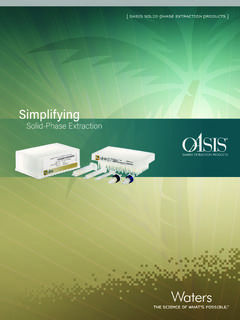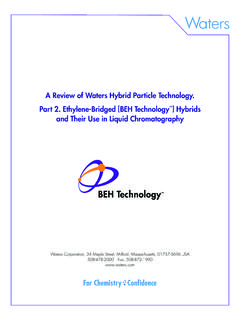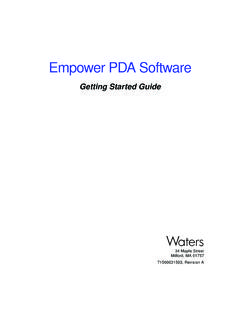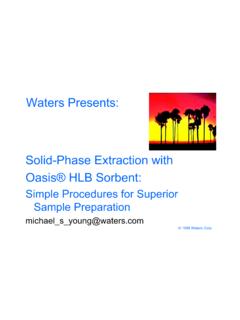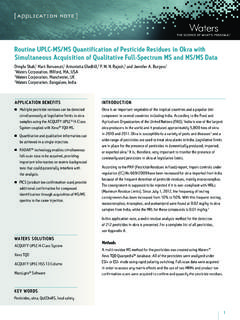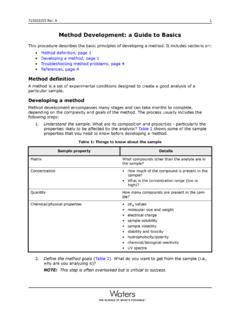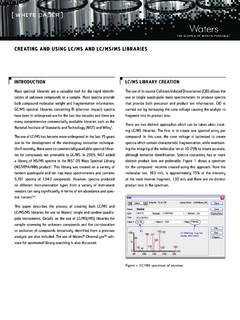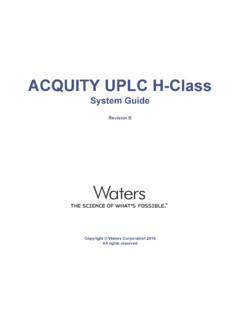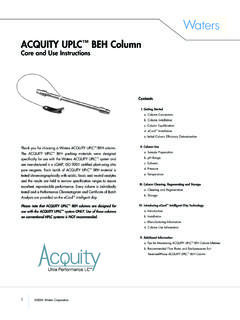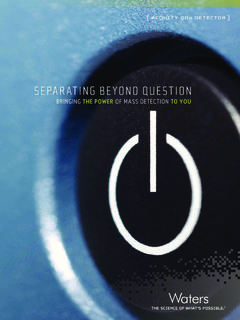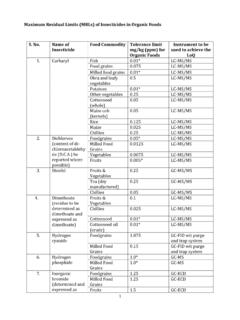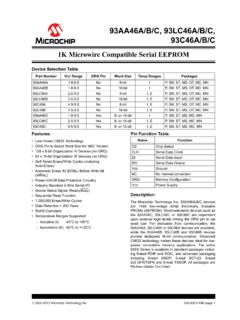Transcription of Controlling Contamination in LC/MS - Waters Corporation
1 715001307 REV. G 1 OF 33. Controlling Contamination in LC/MS Systems Best Practices This document outlines best practices for Controlling Contamination in UPLC/MS and HPLC/. MS systems (both clinical and non clinical). A good Contamination control plan includes measures for preventing, troubleshooting, and cleaning Contamination . Important: This document updates, supersedes, and supplements all other Waters documents on preventing, troubleshooting, and cleaning Contamination . Note: To understand what causes Contamination , see Major contaminants and their sources, page 31. Note: If you have followed the recommendations in this document and still need help with Contamination , contact your Waters representative. 2016 Waters Corporation . ALL RIGHTS RESERVED. 715001307 REV. G 2 OF 33. Table of Contents Preventing Contamination .. 3. Select, prepare, and handle solvents correctly.
2 3. Clean laboratory glassware properly .. 6. Prepare and handle samples correctly .. 7. Use clean fittings and tubing.. 8. Wear gloves .. 8. Use clean columns .. 9. Check laboratory air .. 10. Troubleshooting Contamination .. 11. Isolate the problem to the LC or MS system .. 12. Troubleshoot the LC system .. 12. Troubleshoot the MS system .. 15. Cleaning to Eliminate Contamination .. 16. General guidelines .. 16. Cleaning MS Systems .. 21. Reference Information .. 23. Solvent considerations.. 23. Recommended water purification process .. 29. Gloves .. 30. Major contaminants and their sources .. 31. Contaminant database .. 33. Controlling Contamination IN LC/MS SYSTEMS. 715001307 REV. G 3 OF 33. Preventing Contamination Prevention is the most important factor in Controlling Contamination . It is much easier to prevent Contamination than it is to troubleshoot or eliminate it.
3 To prevent Contamination , follow the steps in this section. Select, prepare, and handle solvents correctly Close attention to the selection and use of solvents (or mobile phases) is a critical safeguard against Contamination (see Possible effects of low quality solvents, page 23). Waters recommends the following procedures when using Note: For more information on solvent recommendations and cautions, see your system user guide. Use clean, particle free solvents Caution: Failure to use the proper grade of solvent for your application causes excessive background noise and loss of sensitivity. When preparing mobile phase, always use chemically clean and particle free solvents (Table 3) and reagents. Solvent must be UPLC grade or a quality level suitable to the application being run. (See Solvent considerations, page 23.). Use fresh solvents Use the freshest solvents available; do not store solvents without taking measures to prevent microbial growth (see Store solvents in clean glass reservoirs with covers, page 6).
4 When solvents are exposed to the atmosphere, they become vulnerable to airborne Contamination . Caution: If using organic solvents, pay attention to the expiration date suggested by the manufacturer. Open bottles of solvent can become contaminated. 1. The recommendations are based on experiences in Waters ' laboratories. Controlling Contamination IN LC/MS SYSTEMS. 715001307 REV. G 4 OF 33. Use ultra pure water Use ultra pure water (defined as water that has been purified through a system that targets contaminants detrimental to UPLC /MS and HPLC/MS systems). Note: See Recommended water purification process, page 29. Ultra pure water is sterile and contains no particles greater than microns, no detectable ionizable compounds (>18 resistivity), and low UV absorbance at the monitoring wavelengths. Use of ultra pure water reduces the number of impurities in the water that can collect on the column during equilibration with the weak solvent.
5 Prevent microbial growth Aqueous mobile phases and water are susceptible to microbial growth, which can cause peaks to appear during gradient operation and increase background absorbance during isocratic operation. Microbial growth can also block filters, frits, and columns, and can cause check valves to malfunction. Such problems can cause high column or pump back pressure and ultimately lead to premature column failure and system shutdown. To prevent microbial growth in mobile phase, prepare, filter, and degas aqueous mobile phase daily. During shutdown or over a long period (such as a weekend), flush the system completely with water. Then flush with 10% (minimum) of an appropriate organic solvent (such as acetonitrile or methanol). Caution: To prevent microbial Contamination , do not store the system in water or >90% aqueous mobile phase.
6 Controlling Contamination IN LC/MS SYSTEMS. 715001307 REV. G 5 OF 33. Minimize the use of additives Caution: To prevent microbial growth, do not add additives to stock bottles. To reduce background, use the lowest concentration of mobile phase additive (for example, acid, base, or buffer that is compatible with good, stable chromatography). The more additive you use, the more Contamination can be introduced into the mobile phase. When developing a new method or transferring an old one to a new column, eliminate any additives that no longer affect the chromatography. For example, TEA is no longer necessary on many columns to obtain good peak shape for basic compounds. Use the highest quality additives available (at minimum, LC/MS grade additives). Use additives (for example, formic acid) that have low concentrations of iron and other metal ions.
7 Acetic acid can contain a significant amount of iron and other metal ions. To prevent precipitation, avoid using inorganic salts or additives in high organic eluents. Such salts or additives can precipitate at the high organic end of the gradient. Use additives that are volatile and compatible with mass spectrometers. Caution: If you are using a mass spectrometer, avoid using non volatile additives such as sodium (Na+), potassium (K+), or phosphate (PO43 ). Caution: Some additives can be incompatible with mass spectrometers. Consult the documentation shipped with your system for compatible additives. Volatile additives containing ammonium (NH4+), acetate, formate, or carbonate are recommended. Caution: Solvents with a pH greater than 10 dissolve silica. If your system contains fused silica and glass components (for example, if you have a nanoACQUITY or M Class UPLC system), avoid using solvents with a pH greater than 10.
8 Avoid storing the system in high pH. Flush and store in methanol or a minimum of 10% organic with no additives or buffers. To flush the system after using mobile phase containing additives, flush the system for at least 5 minutes (at least 50 mL of water). Follow with 10% (minimum) of an appropriate organic solvent (such as acetonitrile or methanol). Use miscible solvents Make sure all solvents and samples, including additives, are miscible. Proteins (from tissues, blood, or serum samples) can precipitate in high (>40%) organic solvents. The precipitated proteins can clog injectors and tubing, or adsorb the analyte or contaminants. Controlling Contamination IN LC/MS SYSTEMS. 715001307 REV. G 6 OF 33. Store solvents in clean glass reservoirs with covers Store mobile phases in clean amber or brown stained borosilicate glass reservoirs (see Clean laboratory glassware properly, page 6).
9 Borosilicate glass must be type 1, class A, or type Caution: The brown bottles in which the manufacturer ships solvents are not borosilicate and must not be used to store aqueous solutions. Caution: Never store liquids in plastic, which can contain plasticizers (for example, phthalates) and thus promote organic Contamination . Cover the reservoir to prevent airborne contaminants from entering the solvent. To cover the reservoir, use aluminum foil or caps supplied with the system. Caution: Do not use Parafilm or other plastic films to cover solvent reservoirs. Use the smallest solvent reservoir appropriate for your analysis (it depends on your flow rate and the length of your runs). Do not top off solvents. Instead, discard old solvent, rinse the bottles and solvent inlet filters with the solvent that is used, and then refill with fresh solvent.
10 Finally, prime the system. Clean laboratory glassware properly Any glass container used to prepare or store mobile phase must be thoroughly cleaned before use. Standard cleaning process Caution: Never wash glassware with detergents or in a dishwasher. Caution: Always clean glassware with the same mobile phase/solvent you use for the chromatography. Rinse glassware with organic solvent and then water. Aggressive cleaning process If more aggressive cleaning is required (for example, when the container's history is unknown), use the following procedure: 1. Sonicate with 10% formic or nitric acid, then water, then methanol or acetonitrile, then water. 2. Repeat two more times. Controlling Contamination IN LC/MS SYSTEMS. 715001307 REV. G 7 OF 33. 3. Store glassware used to prepare or store mobile phase separately from other common . use glassware.
